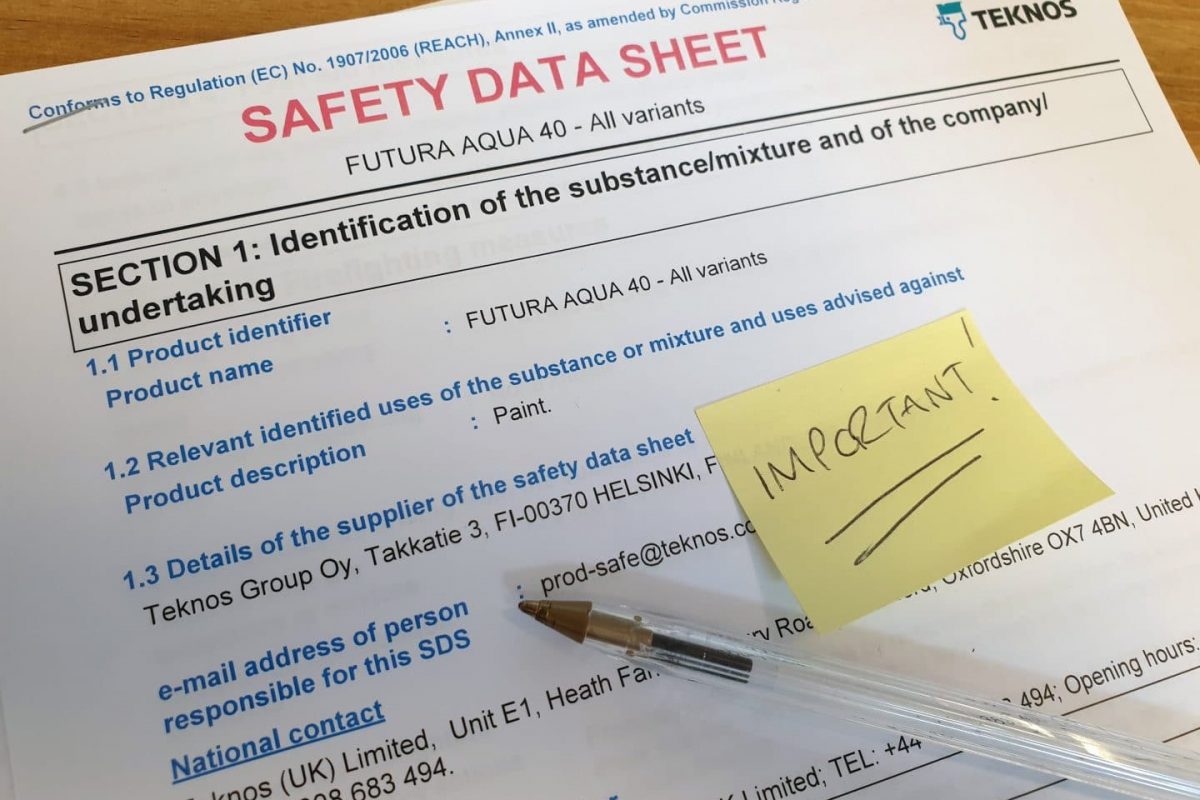As part of legislation, all industrial paint products require Safety Data Sheets. In the below article, we will explain what each section of a Safety Data Sheet means.
The Paint Safety Data Sheet Legislation
Safety data sheets provide information on chemical products. They help users of those chemicals able to make a risk assessment. Paint Safety Data Sheets describe the hazards the chemical presents. They also give information on handling, storage and emergency measures in case of accident.
Safety data sheet information may lead to guidance appropriate for your task. By law, suppliers of chemicals such as paint must provide an up to date safety data sheet if a substance is dangerous for supply.
Promain’s Caution
A safety data sheet is not a risk assessment. You should use the information it contains to help make your own assessment. As well as receiving chemicals you may supply them to others. If you do, you must pass on information (as safety data sheets) to those whom you supply. This is important if you are subcontracting painting to another user.
Understanding Safety Data Sheet Sections
Section 1 – Identification
- This identifies the name of the chemical on the SDS. It also states the recommended uses. It also provides the essential contact information of the supplier. You will find telephone numbers and addresses.
Section 2 – Hazard(s) identification
- This section includes the hazards of the chemical. The hazards will also have any appropriate warning information users may need.
Section 3 – Composition/information on ingredients
- This section identifies the ingredient(s) contained in the product. It will include other chemicals such as impurities and stabilizing additives. This section includes information on substances, mixtures, and all chemicals where a “trade secret” is claimed.
Section 4 – First-aid measures
- this section describes the initial care that should be given by untrained responders to an individual who has been exposed to the chemical.
Section 5 – Fire-fighting measures
- This section lists recommendations for fighting a fire that involves this paint. This includes suitable extinguishing techniques, equipment, and chemical hazards from fire.
Section 6 – Accidental release measures
- This section provides recommendations on the appropriate response to spills, leaks, or releases. This includes containment and clean-up practices. These will help to prevent or minimize exposure to people, properties, or the environment. It may also include recommendations distinguishing between responses for large and small spills. For example, the spill size / volume has a significant impact on the hazard.
Section 7 – Handling and storage
- Section 7 provides guidance on the safe handling practices and conditions for safe storage of the paint chemical. It will also include incompatibilities.
Section 8 – Exposure controls/personal protection
- Here you will find indications on exposure limits, and engineering controls. You will also find info on personal protective equipment (PPE) measures that you can use to minimize worker exposure.
Section 9 – Physical and chemical properties
- This section identifies physical and chemical properties of the substance or mixture.
Section 10 – Stability and reactivity
- This section describes the reactivity hazards of the chemical and the chemical stability information. Furthermore, this section is broken into 3 parts: reactivity, chemical stability, and other.
Section 11 – Toxicological information
- Section 11 identifies toxicological and health effects information. Otherwise it will indicate that such data is not available. This includes routes of exposure, possible symptoms, acute and chronic effects, and numerical measures of toxicity.
Section 12 – Ecological information
- Section 12 provides information to evaluate the environmental impact of the paint chemical(s). Subsequently, this is if the paint were released to the environment.
Section 13 – Disposal considerations
- Section 13 provides guidance on proper disposal practices, recycling or reclamation of the chemical(s) and the packaging. It will also state safe handling practices. To minimize exposure, this section should also refer the reader to Section 8 of the SDS.
Section 14 – Transport information
- This section includes guidance on classification information for shipping and transporting of hazardous chemical(s) by road, air, rail, or sea. If a product is hazardous, UN numbers will be listed. Consequently, this might be why your paint costs a lot to ship!
Section 15 – Regulatory information
- Section 15 identifies the safety, health, and environmental regulations specific for the product. This will show info that you can’t find elsewhere on the SDS.
Section 16 – Other information
- Section 16 indicates the dates of writing of the SDS or when the last revision was made. The SDS may also state where the changes have been made to the previous version. Therefore, you may wish to contact the supplier for an explanation of the changes. Furthermore, it may also include other useful information.
In conclusion, if you require further clarity, please contact our technical team. We are available weekdays on 01462 421333.




